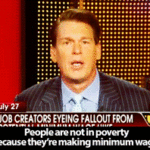Woohoo (er yes, this was on my phone)
A trillion dollars in student loan debt right now. A trillion right. A TRILLION dollars. We are lending money that we don’t have to kids that will never be able to pay it back, to educate them for jobs that no longer exist.
Mike Rowe on Real Time with Bill Maher
One of the best explanations I’ve ever heard.
(via meggielee22)
Orson Scott Card accuses Obama of preparing to set up a dictatorship
Orson Scott Card accuses Obama of preparing to set up a dictatorship
Holy crap this article. Now, he pretends to couch it as “Just a thought experiment,” but then goes on to compare Obama to both Neville Chamberlain and Augustus Cesear (!)
Oh and then later in the article talks about how Obama will use “young urban men” to form his police state army
“But it sure sounds plausible, doesn’t it? Because, like a good fiction writer, I made sure this scenario fit the facts we already have – the way Obama already acts, the way his supporters act, and the way dictators have come to power in republics in the past.
Just keep your head down, and you’ll be OK. Unless your children repeat at school things you said in the privacy of your home. Unless an Obama crony wants your house or your job. Unless you tell the wrong joke to the wrong people. Unless you have already written or said dangerous things that will come back to get you shot trying to avoid arrest …
Just kidding. Because if I really believed this stuff, would I actually write this essay?”
Yeah. I don’t believe you think this entirely made up. Seen to much other stuff from Card’s mind of late. And that’s not even going into his anti-homosexual stuff.
Look, Ender’s Game is a brilliant book and one of my favorites. I’ll see the movie. But I’m pretty sure the author has long since jumped off the deep end.
In Britain, students don’t begin paying off their loans until they find stable employment, and the cost is in proportion to their earnings. Australia similarly ties the cost of paying off the loan to the income of the graduate. In Denmark, education is considered a right by the people and an investment by the government, and is therefore free. Some students are even offered a stipend by the government to defray costs. Norway has a similar system of higher education, and in Sweden, students pay only a small fee.
In America? The university is considered a commodity, one that can easily be purchased by the wealthy, but not the poor. These approaches represent a fundamentally different cultural attitude: elsewhere, education is a public good, an investment or a right; in the U.S., it’s a privilege reserved for wealthy elites.
Why Russia Turned Against The Gays
Why Russia Turned Against The Gays
Looks like Brooks wasn’t so wrong when he portrayed Russia returning to fundamentalist religion in World War Z
Fox News host Neil Cavuto has a special message for living-wage activists: Deal with it. “It’s like jobs aren’t enough these days,“ he said on Tuesday. “They better pay well, or folks just aren’t applying for them at all.” As proof, he cited his own teenage years serving fried fish in Connecticut:
Only in America today, can our politicians bemoan a livable wage, forgetting a lot of folks would be grateful for any wage, any chance, any job, anytime. All I know is as soon as I turned 16 and heard a fast food chain called Arthur Treacher’s was opening a store in my town of Danbury, Connecticut. I stood in a line for a position—any position. I got the job, and soon rocketed to relief manager, then weekend manager, then by 16 and a half, full-time store manager! And it all started at two bucks an hour. And all the fish I could eat.
That’s a good story. But the math makes the opposite point Cavuto intended—adjusted for inflation, he made a lot more money as a teenager than the fast food employees who walked off their jobs in seven US cities this week. Cavuto says he made $2 per hour when he was 16, which would have been around late 1974. That’s $9.47 per hour in today’s dollars—or $.28 per hour more than Washington state’s minimum wage, which is the nation’s highest. Cavuto made the equivalent of $1.02 per hour more than the current minimum wage in Connecticut today and $2.22 per hour more than the current federal minimum wage. His starting wage was $2.17 more than Saavedra Jantuah made at the Burger King on 34th St. in New York City before she walked off the job in protest last November because she was unable to feed her son.
Cavuto’s riff also misses the larger point, which is that the living-wage fight isn’t about 16-year-olds with no kids whose parents cover their basic living expenses. The median fast food worker is 28 years old, and the median female fast food worker is 32. Their wages have dropped an average of 36 cents since 2010. And they’re making less than Neil Cavuto ever did.



























